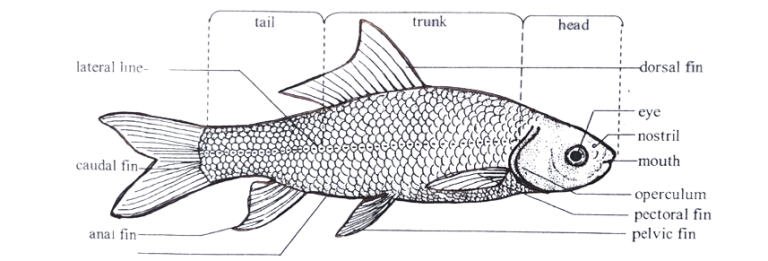Labeo rohita, commonly known as the Rohu, is a freshwater fish species belonging to the Cyprinidae family. Here are some key features of the external morphology of Labeo rohita:
Image source: External Morphology of Labeo rohita | Rohu | Diagram
Body Shape:
Labeo rohita has a streamlined and elongated body shape, typical of most fish. The body is laterally compressed, meaning it is flattened from side to side. The body shape is well adapted for swimming efficiently in water.
Size:
Rohu can grow quite large, reaching an average length of about 1 meter (3 feet) and weighing up to 25 kilograms (55 pounds). However, the size can vary depending on the habitat and growth conditions.
Scales:
The body of Labeo rohita is covered with cycloid scales, which are thin and smooth scales that provide protection. These scales overlap each other, allowing flexibility and reducing drag in the water.
Coloration:
Rohu generally has a silver or silvery-gray coloration on its body. The back is darker, ranging from gray to olive-brown, while the belly is lighter. The coloration can vary depending on the environment, age, and breeding condition of the fish.
Fins:
Labeo rohita has various types of fins that aid in locomotion and stability. These include:
Dorsal Fin:
Located on the back of the fish, the dorsal fin is usually long and divided into two parts. The anterior portion has sharp spines, while the posterior part consists of soft rays.
Caudal Fin:
The caudal fin, also known as the tail fin, is deeply forked and helps in propulsion and maneuvering.
Anal Fin:
Positioned on the ventral side near the anus, the anal fin aids in stabilizing the fish during swimming.
Pectoral Fins:
Found on the sides, just behind the gills, the pectoral fins assist in steering and balancing.
Pelvic Fins:
Located on the ventral side of the fish, near the abdomen, the pelvic fins help in maintaining balance and maneuvering.
Mouth and Barbels:
Labeo rohita has a terminal mouth, meaning it is located at the anterior end of the body. It has two pairs of sensory barbels near the mouth: one pair of maxillary barbels and one pair of rostral barbels. These barbels aid in locating food and detecting changes in the environment.
These are some of the key external features of Labeo rohita (Rohu). The specific morphology may vary slightly depending on factors such as age, sex, and environmental conditions.
There is reasonable evidence that this article is machine-generated. Posting such content is considered fraud. Fraud is discouraged by the community and may result in the account being Blacklisted.
Guide: Why and How People Abuse and Defraud
If you believe this comment is in error, please contact us in #appeals in Discord.